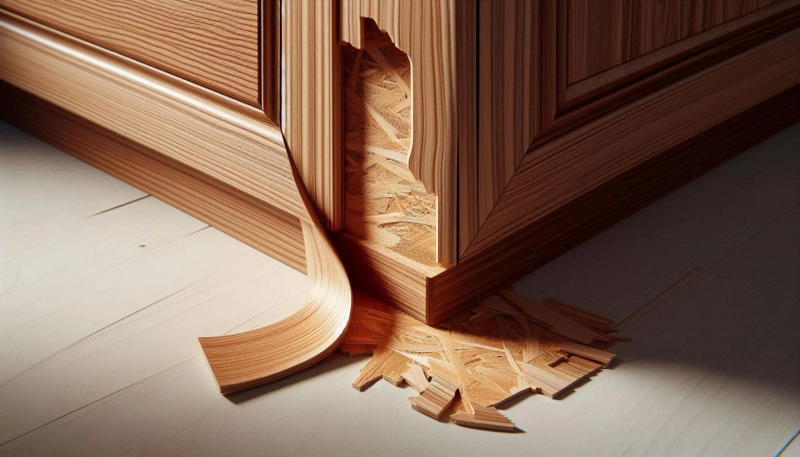Determining whether your cabinets are made of solid wood or veneer is crucial for maintenance, refinishing, and understanding their value. While both materials have their advantages, knowing the difference can help you make informed decisions about your cabinetry.
Definition of Wood and Veneer
What is Solid Wood?
Solid wood cabinets are made entirely from natural wood. Each component of the cabinet, including the doors, frames, and shelves, is constructed from a single piece or multiple pieces of the same type of wood. Solid wood is prized for its durability, natural beauty, and ability to be refinished multiple times.
What is Veneer?
Veneer cabinets consist of a thin layer of real wood or synthetic material glued onto a substrate, usually made from particleboard, MDF (Medium Density Fiberboard), or plywood. Veneers provide the appearance of solid wood at a lower cost and can be designed to mimic various wood grains and finishes.
Physical Examination
1. Checking the Edges
One of the simplest ways to determine if cabinets are made of wood or veneer is by examining the edges. Solid wood will show continuous grain patterns along the edges, while veneer will reveal a thin layer adhered to a substrate. Look closely at the corners and edges where the material might be more exposed.
2. Inspecting the Grain Pattern
Natural wood has unique, inconsistent grain patterns and textures, whereas veneer often displays more uniform and repeated patterns due to its manufacturing process. By inspecting larger surfaces, you can observe the continuity and natural variations in solid wood compared to the repetitive patterns in veneer.
3. Knocking and Sound Test
Gently knock on different parts of the cabinet. Solid wood produces a deeper, more resonant sound, while veneer, attached to a hollow or composite substrate, sounds lighter and more hollow. This test can be particularly useful for distinguishing between high-quality veneer and solid wood.
Practical Methods
Method-1. Examine the Cabinet Interiors
The interior construction of the cabinet can provide clues about the material. Solid wood interiors will show consistent grain patterns, even in less visible areas, while veneer interiors might expose the underlying substrate, especially in areas with wear and tear.
Method-2. Look for Labels or Manufacturer Information
Many cabinets come with labels or manufacturer information that specify the materials used. This information can usually be found inside the cabinets, on the back, or underneath. Labels can provide definitive answers regarding the composition of your cabinets.
Method-3. Assess the Weight
Solid wood cabinets are generally heavier than their veneer counterparts. If possible, compare the weight of similar-sized components. The substantial weight difference is often noticeable and can indicate solid wood construction.
Method-4. Refinishing Possibilities
If you are considering refinishing your cabinets, the ability to sand and refinish is a key indicator. Solid wood can be sanded down and refinished multiple times, whereas veneer has a thin top layer that can only be refinished lightly before risking damage to the substrate.
Conclusion
Determining if your cabinets are made of solid wood or veneer involves a combination of visual inspection, physical tests, and practical assessments. By examining edges, grain patterns, and weight, you can make an educated determination. Understanding the material composition of your cabinets not only aids in maintenance and refinishing but also helps you appreciate the craftsmanship and value of your cabinetry. Whether solid wood or veneer, each has its unique benefits, and recognizing the difference ensures you make the best choices for your home.


